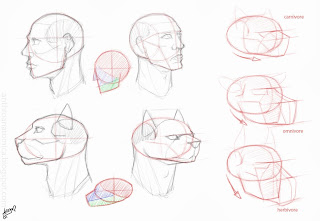 |
| The 2 small intermediate diagrams show the distinction of cranial size (red), nose/face area (blue) and jaw (green). |
Taking this a little further the idea of snout length is certainly up to not only the species and the class but also to your own preference. Felines tend to have a much rounder short snout, canines have a more rectangular and thin snout. Length adaptation is up to you. For example, the sketches above are for carnivores, their main principle is that their jaws are thin and sleek with large forward pointing eyes however the length of the snout is undefined.
Jaws are nothing without teeth, and teeth are distinctly specialised for each class. There are a number of other more subtle differences than teeth to think about, especially if you want to be creating expressive characters. Jaw depth i've mentioned, however it's carnivores that tend to have a much larger jaw opening range to catch and eat pray. Useful for expressions showing rage and anger. Due to their large teeth, particularly their canines, carnivores have limited side to side motion which herbivore use to rotate their jaws to grind plant matter. Side to side motions are more or less reserved to show puzzlement or thinking.
 |
| Ahhhhhh a splinter! |
 |
| Huh? |



No comments:
Post a Comment